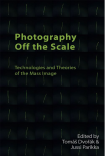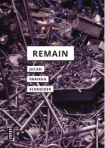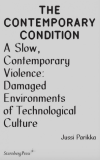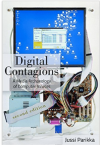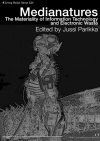Archive
The Environmental Audiotour at the Helsinki Biennial
Helsinki Biennial 2023 is now open and our Aarhus based research group was happy to be involved in the team of curators led by Joasia Krysa.

As part of our work, we also wrote the Environmental Audiotour that can be heard in specific locations in Helsinki and also online. Below a short introduction text to the tour that you can listen to both in English and in Finnish as “Ääniopastus kaupungin luontoon”.
Imagine immersing yourself in data as you discover the intricate architectures of environmental sensing that surround us.
The Environmental Audiotour takes us through different spaces and sites of Helsinki and Vallisaari, their past and future. Real and speculative stories unfold together with elemental forces in the extended urban environment, from water to air and from land to energy. The stories draw our attention to the ecological landscapes as we move through different ’islands’ in the city.
Written by Jussi Parikka, Paolo Patelli, and May Ee Wong, The Environmental Audiotour consists of six audiostories that can be experienced in the South Harbour near the Lyypekinlaituri (1st), in Vallisaari at the ruins of the old Weather Station (2nd), in Hietalahti (3rd), in the Kaisaniemi Botanical Garden (4th and 5th) and in Sörnäinen near the Uniarts Academy of Fine Arts – as well as online.
https://helsinkibiennaali.fi/en/event/critical-environmental-data-the-environmental-audiotour/
References
Samir Bhowmik, “From Nature to Infrastructure: Vallisaari Island in the Helsinki Archipelago.” Environment & Society Portal, Arcadia (Summer 2020), no. 28. https://doi.org/10.5282/rcc/9062.
J.R. Carpenter, This is a Picture of Wind. Longbarrow Press, 2020.
Lorraine Daston, Rules: A Short History of What We Live By. Princeton University Press, 2022.
Gary Genosko,”Four Elements” in: Posthuman Glossary, edited by Rosi Braidotti and Maria Hlavajova. Bloomsbury Academic, 2018.
Heikki Nevanlinna, Ilmatieteiden vaiheita ja vaikuttajia Suomessa. Societas Scientiarum Fennica, 2021
Dietmar Offenhuber, “Data by Proxy — Material Traces as Autographic Visualizations” arXiv:1907.05454, 2019.
Yoko Ono, “Painting for the Wind”, 1961.
Anna Lowenhaupt Tsing, The Mushroom at the End of the World: On the Possibility of Life in Capitalist Ruins. Princeton University Press, 2015.
The project was realised with support from the Helsinki Biennial and the Design and Aesthetics for Environmental Data project (AUFF, Aarhus University, 2022-2024) and the Weather Reports project (AHRC and DFG, 2022-2024).

First signs
First signs of Operational Images existing as a printed book.

Digital Aesthetics Research Centre
The Digital Aesthetics Research Centre (DARC) is one of the centres in our school and faculty. DARC has been operating about 20 years now with a focus on new and emerging art practices from software and net art to sound, visual, and other media. I am happy to continue and support DARC work as the new director.
The news piece here.
Strange Weathers
I am very happy that our Strange Weathers special issue of Neural Magazine is out! It includes new texts, reviews, and interviews with for example Karolina Sobecka, Superflux, Lise Autogena and Joshua Portway, Open Weather, and Jana Winderen. Co-edited with Daphne Dragona, the special issue follows on from our Weather Engines exhibition in Athens (2022, Onassis Stegi) as well as the book we published in that context: Words of Weather, a new vocabulary for a political ecology.
In further news, the exhibition and public program will be continued in Spain in Autumn 2023. A separate announcement on that is forthcoming. In the meantime, enjoy the special issue (and considering subscribing to Neural – or recommending your library to do that).

The cover of the special issue features Sophie Dyer from Open Weather group, from their workshop in Athens in 2022.
Hydromancy by Matterlurgy
Hydromancy by Matterlurgy is a new film and installation on at the John Hansard Gallery (JHG). It is a commission by the JHG and Onassis Stegi (Athens) as part of our on-going Weather Engines project that I am curating with Daphne Dragona.
You can see it on the large digital screens at the Hansard in Southampton (and next year installed in Athens) but also online:
https://jhg.art/video/matterlurgy-hydromancy/
Hydromancy is “filmed on location at the University of Southampton’s National Oceanography Centre, a globally renowned centre for developing technologies that investigate the world’s oceans, earth systems and biosphere, Hydromancy blends documentary with artistic intervention, considering the ocean as both a sensory environment and scientific object. As viewers, we visit a coral lab bathed in blue light, an engineering workshop, and enter a room bubbling with algae and phytoplankton.”

The Lab and the Field, the Image and the Instrument
I was kindly commissioned this short text about Su Yu Hsin’s frame of reference video installation at the Alexander Levy gallery (Berlin). Originally published by the gallery, here’s the text below as well alongside links to the work.
See here for the Online viewing gallery.
The Lab and the Field, the Image and the Instrument
Su Yu Hsin’s frame of reference (I and II) consists of images about images. The recursive story of environmental data offers a literal frame of reference about images that are captured in multiple windows. These moving images are nested inside other moving images. This assembly of views – scientists in action, rivers in flow, aerial views, simulations, and graphs – comes out of a patchwork of instruments of sensing that also have be nested somewhere on the field in order to transport data somewhere else. Not that the field, the lab, and data are considered separate. Any situated knowledge does not imply stand-point stability but the existence of relations, vectors of movement, and the painstaking work of trying to think what scales, what does not. Questions of proximity and distance become reversed so that any objective set of views cannot start as uninvolved distance. Instead, they have to share a terrain and be somewhere, sometime, and for some duration. The intimacy of scientific practice can be breath-taking.
These are some of the visual dilemmas of the Anthropocene landscapes that are not modelled anymore based on the genre of the landscape painting but abstract art: intensities of color, variation, and pattern that become epistemically meaningful for specialist analysis.
The composition of carefully crafted scenes is cinema about instruments. The scenes could be narrated as featuring scientific practice but there’s more at play as you can imagine. It is not that frame of reference is only about scientific practice of measurement and the critical zone of life that covers the planet but that the images become instruments that start to compose the space they are in. They are involved. They are based on but also feed forward observations.
These involved observations are, as Su Yu Hsin tells us, on the ground as the surface layer of life, but they are also off the ground; these spaces are seen through the capacity of the instruments which allow the space to lift from a specific place onto a (data) server across the planetary surface. Instruments that specify place, images that are composed in that space, and yet data that is circulating much beyond those locations. Planetary sensing, and planetary circulation of data are tightly interlinked.
frame of reference is a story of patchy images: particular views in particular time, composed and stitched together after being captured. At this particular time a certain strength wind was passing through this landscape. This patchiness is not mere limitation, but a condition of their own existence as partial views to any site and sight. It is only through the dynamic patchiness of any landscape, field, and observation that a pattern can be spotted; a systemic property determined by a heterogeneous ground.
Gradually, live shots make way for data-views; lidar imaging, simulations, satellite sensing and more. Any view taken is taken twice: first as moving images, then as moving data; first as recording of light and other signals, then as model and simulation composed of those signals. The proliferation of patchy images also makes us realise the change in what sort of images we are watching.
Change and flow are one example of the patches in motion, concretely visible on the image surfaces in Su Yu Hsin’s work. The centrality of flowing water as well as submerged views is one indication of circulation too. Any location of a patch is not necessarily contained by its site of observation and the hydropoetic moving images in frame of reference make a point about this aspect of knowing through means of aesthetics. None of this is about a stable thing but a process of composition: a river flow, atmospheric chemistry, soil composition, landscape migration. Only the scales of composition and change vary.
On the ground, in the air, and under water; the images are involved in the elemental mix. The environment is one of material capacity to be sensed as well as already sensing. Su Yu Hsin captures the double-aspect why we are drawn to it: the epistemic and the aesthetic as the two sides why a surface measurement of the Earth can become both data and sensation, measurement and affect. As such, the videos exhibited could easily be seen as perfect illustrations of the past years of art and science work with a special attention being paid to the posthumanities of environmental scales, the material agency of not only the scientists but also the landscapes, and the intensive site of the field that is immanent to the lab also the voice-over speaks of.
But more than illustration, frame of reference becomes a collaborator in all of those endeavours; alongside the field, the lab, and the database, also the image and the studio, the frame and its aesthetic references as a site of participation.
Further reading:
Horton, Zachary (2021) The Cosmic Zoom. Scale, Knowledge, and Mediation. Chicago: University of Chicago Press.
Lowenhaupt Tsing, Anna; Mathews, Andrew S., and Bubandt Nils (2019) “Patchy Anthropocene: Landscape Structure, Multispecies History, and the Retooling of Anthropology” Current Anthropology Volume 60, Number S20, https://www.journals.uchicago.edu/doi/full/10.1086/703391
Grounding
Our video piece Seed, Image, Ground is on display until October 18 at the Grounding exhibition in St Petersburg, at the Dokuchaev Soil Museum. For us, that institutional and narrative context is perfect, considering the book on Vegetal Images we are writing with Abelardo Gil-Fournier features occasional appearances of Dokuchaev, Vernadsky, and others.
Furthermore, the video is featured currently in an exhibition on air/atmosphere in Shenzen, in this one on soil/grounding in St. Petersburg, and next year in a context that adds another elemental twist to the contextualization of Seed, Image, Ground (that was originally commissioned by Fotomuseum Winterthur for their series “Strike/Situations”.)

Lost Islands at the Helsinki Biennial: a conversation with Samir Bhowmik
I had the pleasure to be an advisor for Samir Bhowmik’s art and performance project Lost Islands (2021) that was commissioned by the Helsinki Biennial. Here’s a talk/conversation we did with Samir as part of the public talks program of the Biennial – we discussed the Anthropocene, performance arts, the island and infrastructure, and other themes stemming from the Lost Islands (as well as Samir’s own art-research work).



